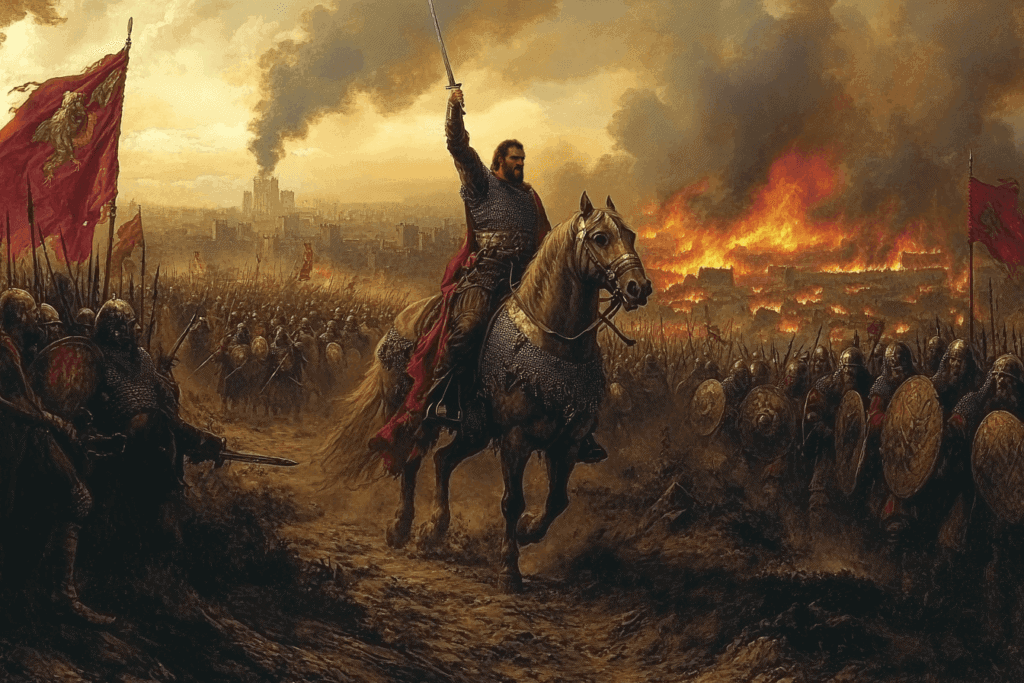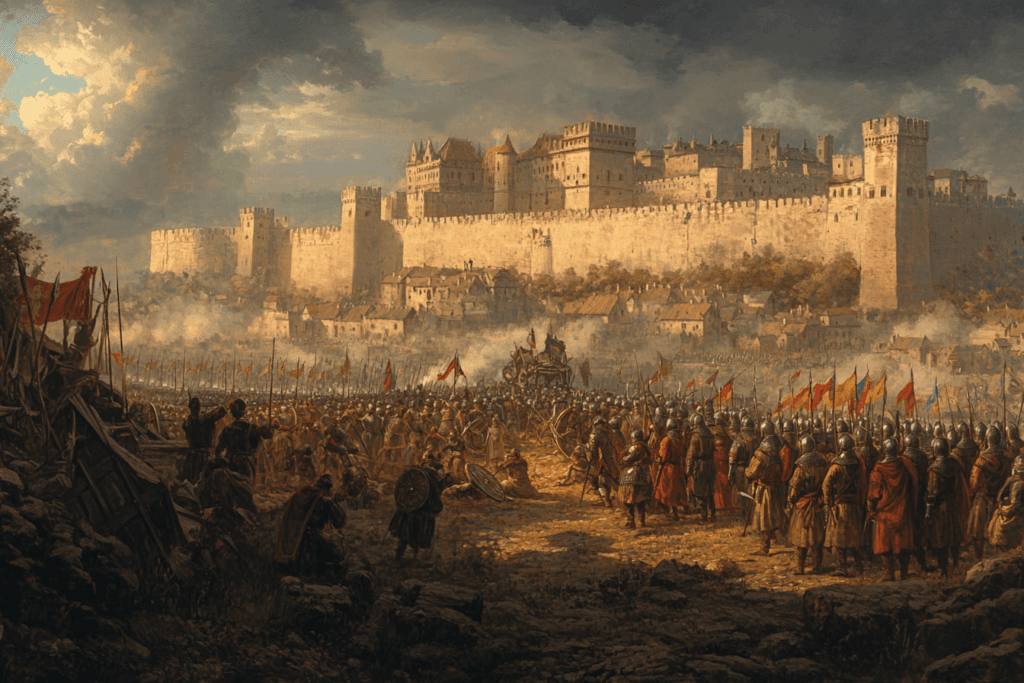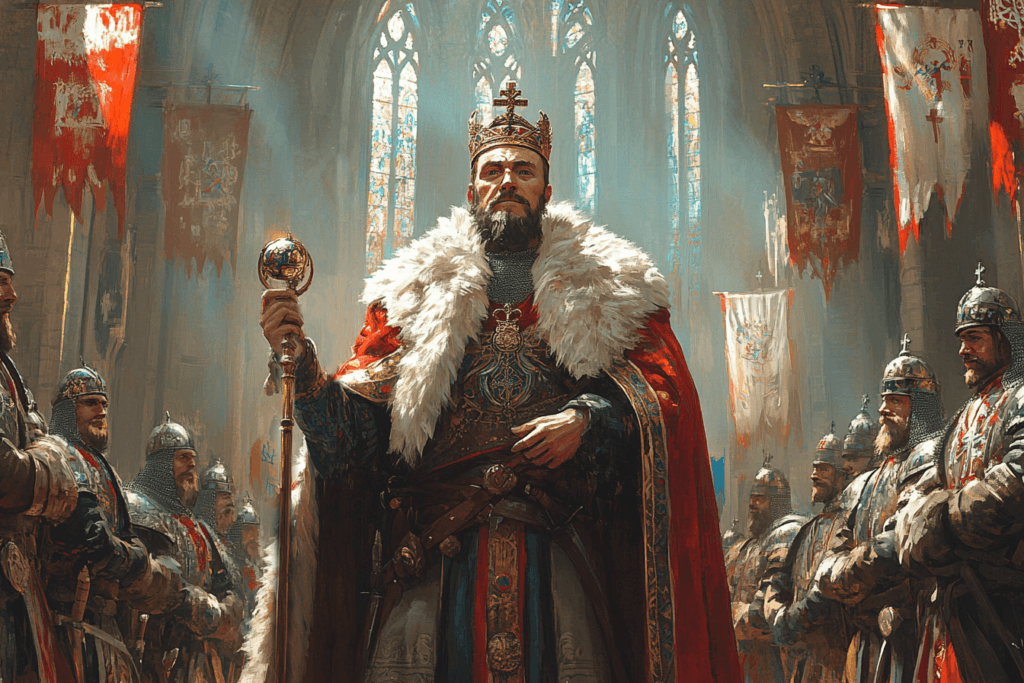
Bolesław III Wrymouth, also known as Bolesław III Krzywousty in Polish, was a pivotal figure in Polish history who ruled as Duke of Poland from 1107 to 1138. Bolesław’s early years were shaped by the political landscape of late 11th century Poland. The central government had weakened significantly, and the young prince found himself in a complex web of power struggles.
Succession and Fraternal Conflict
Zbigniew, born around 1073, was the first-born son of Władysław I Herman, Duke of Poland. Despite being the elder, Zbigniew was considered illegitimate and initially destined for a life in the Church. However, political circumstances changed when opposition from Silesian magnates forced Władysław I to recognize Zbigniew as a potential successor. His half-brother Bolesław, born in 1086, was the son of Władysław I and his second wife, Judith of Bohemia. As the legitimate heir, Bolesław was groomed for rulership from an early age.
Upon the death of Duke Władysław I Herman in 1102, Poland was divided into two independent states ruled by Bolesław and Zbigniew. This arrangement, however, was short-lived. Bolesław, ambitious and determined to unite Poland under his sole rule, soon came into conflict with his elder half-brother.
The first major confrontation occurred in 1103 when Bolesław launched a military campaign into Pomerania. Zbigniew, preferring a peaceful relationship with the Pomeranians, attempted to dissuade Polish knights from participating in Bolesław’s expedition. This action infuriated Bolesław and marked a significant escalation in their rivalry.
In response to Bolesław’s aggressive policies, Zbigniew formed an alliance with Bořivoj II of Bohemia in 1105. Zbigniew promised to pay tribute to Bohemia in exchange for support against his brother. Bolesław countered by allying himself with Kievan Rus and Hungary, sealing this alliance through his marriage to Zbyslava, daughter of Sviatopolk II of Kiev, in 1103.
The Civil War (1106-1107)
The situation deteriorated into full-scale civil war in 1106. Bolesław, with the support of his Kievan and Hungarian allies, launched a decisive campaign against Zbigniew’s territories. The combined forces quickly captured key cities in Zbigniew’s domain, including Kalisz, Gniezno, Spycimierz, and Łęczyca.
Faced with this onslaught, Zbigniew was forced to capitulate. Through the mediation of Baldwin, Bishop of Kraków, a peace treaty was signed at Łęczyca. This agreement officially recognized Bolesław as the Supreme Duke of all Poland, while Zbigniew was allowed to retain Masovia as a fief.

Zbigniew’s Exile and Attempted Return
Despite the peace treaty, tensions remained high. In the winter of 1107-1108, Bolesław accused Zbigniew of failing to fulfill his duties as a vassal, particularly in providing military aid for campaigns against the Pomeranians. Using this as a pretext, Bolesław launched another attack on Masovia, forcing Zbigniew to flee to Prague.
Zbigniew’s exile marked a turning point in the conflict. From Prague, he sought support from various allies, including the Holy Roman Emperor Henry V. This international dimension of the conflict posed a significant threat to Bolesław’s rule.
Imperial Intervention
In 1109, Henry V launched his campaign into Polish territory. The German forces, comprising a substantial army, crossed into Silesia with the intention of subduing Bolesław III and bringing Poland under imperial control. However, the Polish ruler was well-prepared for this incursion and had devised a strategy to counter the imperial threat.
The Siege of Głogów
The most crucial battle of this conflict took place at the Silesian town of Głogów on August 24, 1109. The siege of Głogów became the centerpiece of the Polish defense strategy and a turning point in the war. Bolesław III had fortified the town, recognizing its strategic importance in halting the German advance.

Henry V’s forces laid siege to Głogów, expecting a swift victory. However, the Polish defenders, under Bolesław’s command, put up fierce resistance. The siege was marked by several notable events:
- The use of Polish children as human shields by the German forces, a tactic that shocked contemporaries but failed to break the defenders’ resolve.
- The innovative defensive techniques employed by the Polish garrison, including the use of boiling pitch and other improvised weapons.
- The prolonged nature of the siege, which frustrated Henry V’s plans for a quick campaign.
The successful defense of Głogów was a major blow to Henry V’s expedition. It demonstrated the determination of the Polish forces and the effectiveness of Bolesław III’s defensive strategy.
The Battle of Hundsfeld (Psie Pole)
Following the failed siege of Głogów, Henry V’s army continued its march deeper into Polish territory. However, they were constantly harassed by Polish forces using guerrilla tactics. These hit-and-run attacks weakened and demoralized the German troops.
The culmination of this campaign was the Battle of Hundsfeld, also known as the Battle of Psie Pole (Dog’s Field). While historical details of this battle are somewhat obscure, it is generally accepted that it resulted in a decisive victory for Bolesław III. The Polish forces effectively used the terrain to their advantage, luring the German army into unfavorable positions and inflicting heavy casualties.
The name “Dog’s Field” is said to have originated from the large number of unburied German corpses left on the battlefield, which were devoured by dogs. While this may be a later embellishment, it illustrates the scale of the German defeat in Polish historical memory.

Aftermath
Henry V’s expedition to Poland ended in failure. The Holy Roman Emperor was forced to retreat, his army decimated and his prestige severely damaged. This outcome had several important consequences:
- Polish Independence: The victory solidified Poland’s independence from the Holy Roman Empire. Bolesław III successfully defended Polish sovereignty and thwarted Henry V’s attempts to impose imperial overlordship.
- Bolesław III’s Reputation: The Polish ruler’s military and strategic skills were greatly enhanced by this victory. He became known as one of the most formidable leaders in Central Europe.
Despite the Polish victory over the Holy Roman Empire, two years later, again under pressure from Emperor Henry V, Bolesław allowed Zbigniew to return to Poland and granted him a small domain. However, shortly after his return, Zbigniew was blinded on Bolesław’s orders and died soon after, possibly on July 8, 1113.
Interestingly, Bolesław showed an ability to adapt and seek reconciliation when needed. He regained the favor of his subjects through public penance for his actions against Zbigniew, even making a pilgrimage to the monastery of his patron, Saint Giles, in Hungary.
Consolidation of Power and Expansion
Bolesław’s victory over Zbigniew marked the beginning of his reign as the sole ruler of Poland. Crowned in 1107, he embarked on a series of military campaigns aimed at expanding and consolidating his kingdom. His rule was characterized by a focus on strengthening the state through economic development and territorial expansion.
One of Bolesław’s primary objectives was the conquest of Pomerania, a goal that would occupy much of his reign. The campaign to subdue Pomerania was a long and arduous process, carried out in multiple stages throughout the 1110s and 1120s.
In 1113, Bolesław conquered the northern strongholds along the Noteć River, strengthening his border with the Pomeranians. This initial success was followed by further military expeditions. The conquest of Pomerania was not merely a military endeavor but also a cultural and religious one. Bolesław initiated the process of Christianizing the newly conquered territories, building churches and supporting missionary efforts.

The Pomeranian Campaigns
The conquest of Pomerania was one of Bolesław’s most significant achievements. The region, protected by dense forests and treacherous marshes, was inhabited by a fierce Slavic people who stubbornly clung to their pagan beliefs. The Pomeranians posed a constant threat to Poland, using their coastal position to maintain fleets and build substantial towns like Stettin and Kolberg, from which they launched raids into Polish territory.
In August 1109, Bolesław III Krzywousty marched towards Nakło with a force of around 1,500 cavalry. This relatively small but elite force represented the core of the Polish military might at the time. The use of a small cavalry force was a necessity as the bulk of his forces were deployed against the invading Holy Roman Emperor. The Battle of Nakło resulted in a devastating defeat on the Pomeranians. However, this victory only led to temporary submission. The struggle continued for years, with the Pomeranians fiercely resisting Polish rule.
A significant turning point came in 1120-1124 when Bolesław suppressed a rebellion led by Prince Warcesław of Stettin. The resistance was so fierce that it took the deaths of 18,000 of Bolesław’s followers and the expatriation of 8,000 more before Warcesław finally submitted.
Recognizing that military conquest alone was insufficient, Bolesław understood the need to Christianize Pomerania to fully integrate it into his realm. He enlisted the help of Bishop Otto of Bamberg, who knew Slavic languages and was able to communicate effectively with the Pomeranians. Otto’s missionary efforts, beginning in 1124, were crucial in spreading Christianity throughout the region.
The Christianization of Pomerania was a gradual process. In 1124, Otto converted the southern portions of the land. However, it was only under the threat of extermination that the people of Stettin, a major Pomeranian city, accepted the Christian faith in 1125. In 1128, at the Council of Usedom, Otto appointed his disciple Boniface as the bishop of Julin, establishing the first Pomeranian diocese..

Diplomatic Maneuvers and Alliances
Bolesław was not only a capable military leader but also a shrewd diplomat. He understood the importance of forging alliances to strengthen his position in the region. One of his most notable diplomatic achievements was his alliance with King Niels of Denmark.
This alliance was sealed through a marriage arrangement between Bolesław’s daughter Richeza and Niels’ eldest son, Crown Prince Magnus the Strong. The wedding took place in Ribe around 1127 and was celebrated with great pomp and circumstance. This union not only strengthened Poland’s ties with Denmark but also provided Bolesław with a powerful ally in his ongoing conflicts with Pomerania and the Holy Roman Empire.
Bolesław III Wrymouth himself was married twice. His first marriage was to Zbyslava, a Kievan princess. This union provided him with a pretext to intervene in the internal affairs of Kievan Rus, further expanding his influence. After Zbyslava’s death, Bolesław married Salomea of Berg, a German noblewoman. This second marriage influenced a shift in Polish foreign policy, with Bolesław seeking to improve diplomatic relations with his western neighbors in the latter part of his reign.

The Statute of Succession and Its Consequences
Perhaps the most consequential and controversial decision of Bolesław’s reign came near its end. In an attempt to prevent disputes over succession after his death, Bolesław issued a document known as the “Statute of Succession” or “The Testament”. In this will, he divided his kingdom among his sons, despite his own father having made the same mistake.
While Bolesław’s intentions were to maintain stability and prevent fratricidal conflicts, the decision ultimately had the opposite effect. The division of the realm led to a period of feudal fragmentation in Poland that lasted for almost two centuries. This era, known as the period of regional disintegration, significantly weakened the Polish state and made it vulnerable to external threats.
Legacy and Historical Significance
Despite the long-term consequences of his succession plan, Bolesław III Wrymouth left an indelible mark on Polish history. Bolesław maintained his position as one of the most powerful rulers in Central Europe until his death. He passed away on October 28, 1138, leaving behind a significantly expanded and more influential Polish state.
Bolesław’s reign saw significant territorial expansion, particularly the conquest and integration of Pomerania, which gave Poland access to the Baltic Sea. This expansion not only increased Poland’s territory but also its economic and strategic potential.
Furthermore, Bolesław played a crucial role in the Christianization of Pomerania, a process that had far-reaching cultural and political implications. By supporting missionary efforts and establishing ecclesiastical structures in the newly conquered territories, he laid the groundwork for their long-term integration into the Polish realm.




